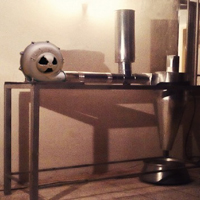CFD-based numerical simulation of cyclone separator for separating stigmas from petals of saffron

Published:15 October 2020
Abstract Views: 2187
PDF: 550
HTML: 930
HTML: 930
Publisher's note
All claims expressed in this article are solely those of the authors and do not necessarily represent those of their affiliated organizations, or those of the publisher, the editors and the reviewers. Any product that may be evaluated in this article or claim that may be made by its manufacturer is not guaranteed or endorsed by the publisher.
All claims expressed in this article are solely those of the authors and do not necessarily represent those of their affiliated organizations, or those of the publisher, the editors and the reviewers. Any product that may be evaluated in this article or claim that may be made by its manufacturer is not guaranteed or endorsed by the publisher.
Similar Articles
- Giorgia Cocolo, Silvia Curnis, Maibritt Hjorth, Giorgio Provolo, Effect of different technologies and animal manures on solid-liquid separation efficiencies , Journal of Agricultural Engineering: Vol. 43 No. 2 (2012)
- Noureldin Sharaby, Artyom Doroshenko, Andrey Butovchenko, Modelling and verification of sesame seed particles using the discrete element method , Journal of Agricultural Engineering: Vol. 53 No. 2 (2022)
- Qing Guo, Huihuang Xia, A review of the discrete element method/modelling in agricultural engineering , Journal of Agricultural Engineering: Vol. 54 No. 4 (2023)
- Chiara Antinoro, Vincenzo Bagarello, Vito Ferro, Giuseppe Giordano, Massimo Iovino, Testing the shape-similarity hypothesis between particle-size distribution and water retention for Sicilian soils , Journal of Agricultural Engineering: Vol. 43 No. 3 (2012)
- Shadrack Kwadwo Amponsah, Ahmad Addo, Komla Dzisi, Jean Moreira, Sali Atanga Ndindeng, Comparative evaluation of mechanised and manual threshing options for Amankwatia and AGRA rice varieties in Ghana , Journal of Agricultural Engineering: Vol. 48 No. 4 (2017)
- Hossein Khaledian, Homayoun Faghih, Ata Amini, Classifications of runoff and sediment data to improve the rating curve method , Journal of Agricultural Engineering: Vol. 48 No. 3 (2017)
- Francisco Ayuga, Present and future of the numerical methods in buildings and infrastructures areas of biosystems engineering , Journal of Agricultural Engineering: Vol. 46 No. 1 (2015)
- Diwei Wu, Shaohua Zeng, Shuai Wang, Yanan Chen, Yidan Xu, Zanthoxylum infructescence detection based on adaptive density clustering , Journal of Agricultural Engineering: Vol. 55 No. 2 (2024)
- Ugo Lazzaro, Caterina Mazzitelli, Benedetto Sica, Paola Di Fiore, Nunzio Romano, Paolo Nasta, On evaluating the hypothesis of shape similarity between soil particle-size distribution and water retention function , Journal of Agricultural Engineering: Vol. 54 No. 4 (2023)
- Xin Du, Cailing Liu, Changqing Liu, Qixin Sun, Shufa Chen, A novel method for measurement of the angle of repose of granular seeds in discrete element methods , Journal of Agricultural Engineering: Vol. 54 No. 2 (2023)
You may also start an advanced similarity search for this article.

 https://doi.org/10.4081/jae.2020.1091
https://doi.org/10.4081/jae.2020.1091 










